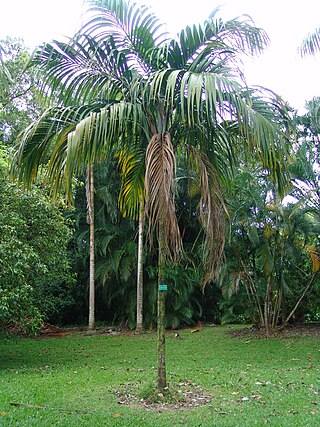
Cheirolophus crassifolius, the Maltese centaury, Maltese rock-centaury or Widnet il-Baħar, is a species of flowering plant in the family Asteraceae. It is endemic to Malta, where it has been the national plant of Malta since 1973. Its natural habitats are cliffs and coastal valleys. It is threatened by habitat loss.

Astrocaryum alatum is a species of palm with edible nuts, a flowering plant in the family Arecaceae. It is a common species found many types of rainforests and swamps in Honduras, Costa Rica, Nicaragua and Panama.

Carpoxylon macrospermum is a species of palm tree endemic to Vanuatu, and the only species in the genus Carpoxylon.

Cryosophila is a genus of medium-sized fan palms that range from central Mexico to northern Colombia. Species in the genus can be readily distinguished from related genera by their distinctive downward-pointing spines on the stem, which are actually modified roots. They are known as the "root spine palms".
Cryosophila grayumii is a species of flowering plant in the family Arecaceae. It is found only in Costa Rica. It is threatened by habitat loss.

Cryosophila guagara is a species of flowering plant in the family Arecaceae. It is found in Costa Rica and Panama. It is threatened by habitat loss.

Cryosophila kalbreyeri is a species of flowering plant in the family Arecaceae. It is found in Colombia and Panama. It is threatened by habitat loss.

Cryosophila nana is a species of flowering plant in the family Arecaceae. It is found only in Mexico. It is threatened by habitat loss.

Deckenia nobilis is a species of flowering plant in the family Arecaceae. It is monotypic within the genus Deckenia, and is endemic to the Seychelles, where it is threatened by habitat loss. It was described in 1870.
Dypsis canescens, also known as Chrysalidocarpus canescens, is a species of flowering plant in the family Arecaceae. It is endemic to the Sambirano region of northwestern Madagascar. It was identified in 1913. It is probably extinct, given that it has not been seen for half a century.

Juania australis, the Chonta palm, is a species of flowering plant in the family Arecaceae, the only species in the genus Juania. It is a solitary trunked palm tree which is endemic to the Juan Fernández Islands archipelago in the southeast Pacific Ocean west of Chile.

Jubaeopsis caffra, the Pondoland palm, is a flowering plant species in the palm family (Arecaceae). It belongs to the monotypic genus Jubaeopsis.

Nephrosperma vanhoutteanum is a species of palm tree, and the only species in the genus Nephrosperma. It is found only in Seychelles, where it is threatened by habitat loss.

Normanbya is a monotypic genus of palms containing the single species Normanbya normanbyi, which is known by the common name black palm It is endemic to Queensland, Australia and is threatened by habitat destruction.

Phoenicophorium, the thief palm, is a monotypic genus of flowering plant in the family Arecaceae. The sole species is Phoenicophorium borsigianum.

Schippia concolor, the mountain pimento or silver pimeto, is a medium-sized palm species that is native to Belize and Guatemala. Named for its discoverer, Australian botanist William A. Schipp, the species is threatened by habitat loss. It is the sole species in the genus Schippia.

Verschaffeltia splendida is a species of flowering plant in the family Arecaceae. It is the only species in the genus Verschaffeltia.

Guettarda is a plant genus in the family Rubiaceae. Most of these plants are known by the common name velvetseed.

Cyrtostachys renda, also known by the common names red sealing wax palm and lipstick palm, is a palm that is native to Thailand, Malaysia, Sumatra and Borneo in Indonesia. It is the only species of the genus Cyrtostachys that can be found to the west of the Wallace Line, the faunal boundary separating the biogeographic realms of Asia and Wallacea. Cyrtostachys renda's name is derived from several words: the Greek prefix κυρτό- (cyrto-) meaning bent or curved, the Greek word σταχυς (stachys) meaning "an ear of grain", and "renda" a Malayan Aboriginal word for palm, which happens to be homonymous to the Portuguese word "renda," meaning income.
The Williams Conservatory is located in Laramie, Wyoming at the campus of the University of Wyoming. It opened in 1994. The main greenhouse is filled with exotic plants from various climates and biomes. The Conservatory is open daily for public and it receives hundreds of visitors each year.



















